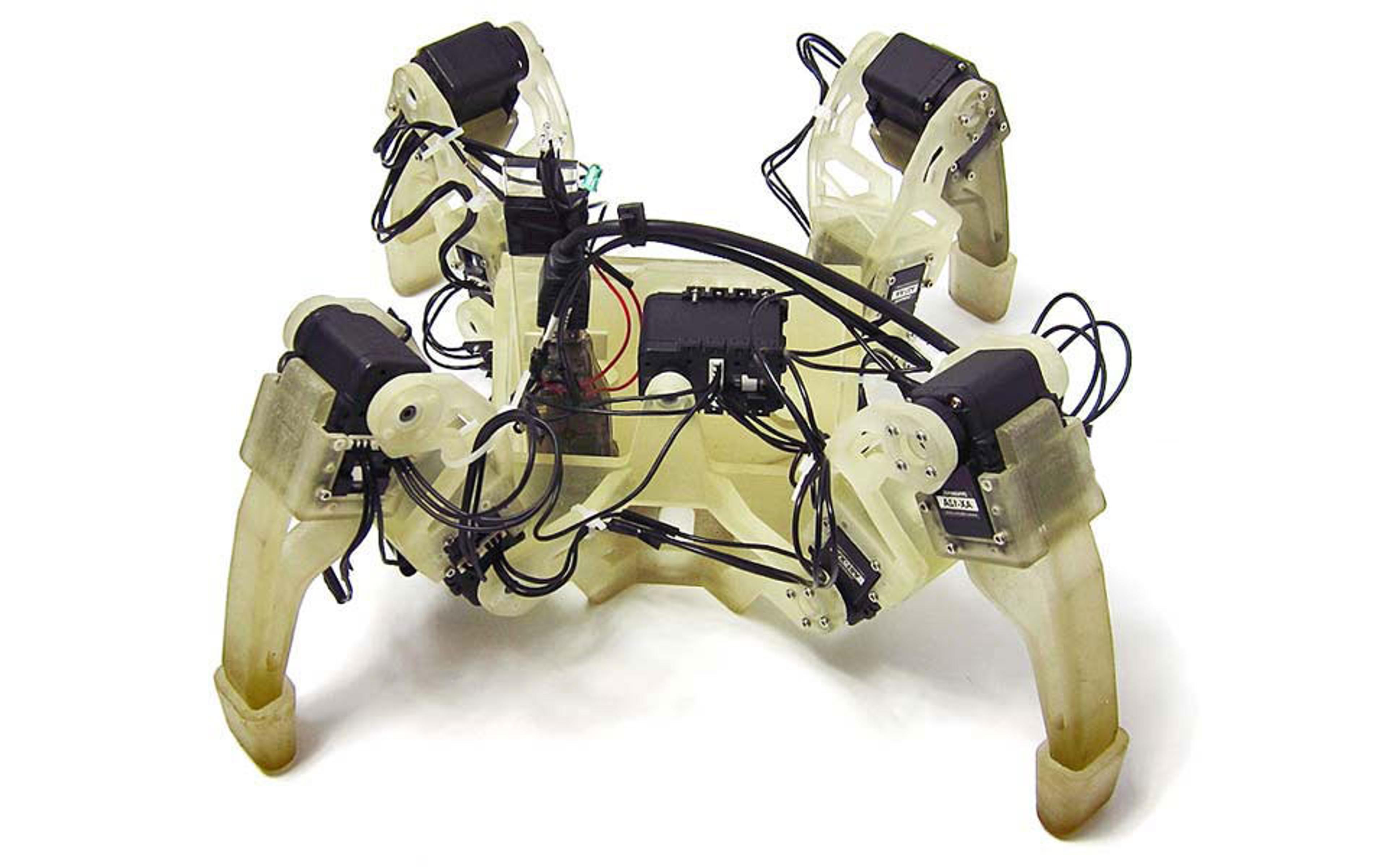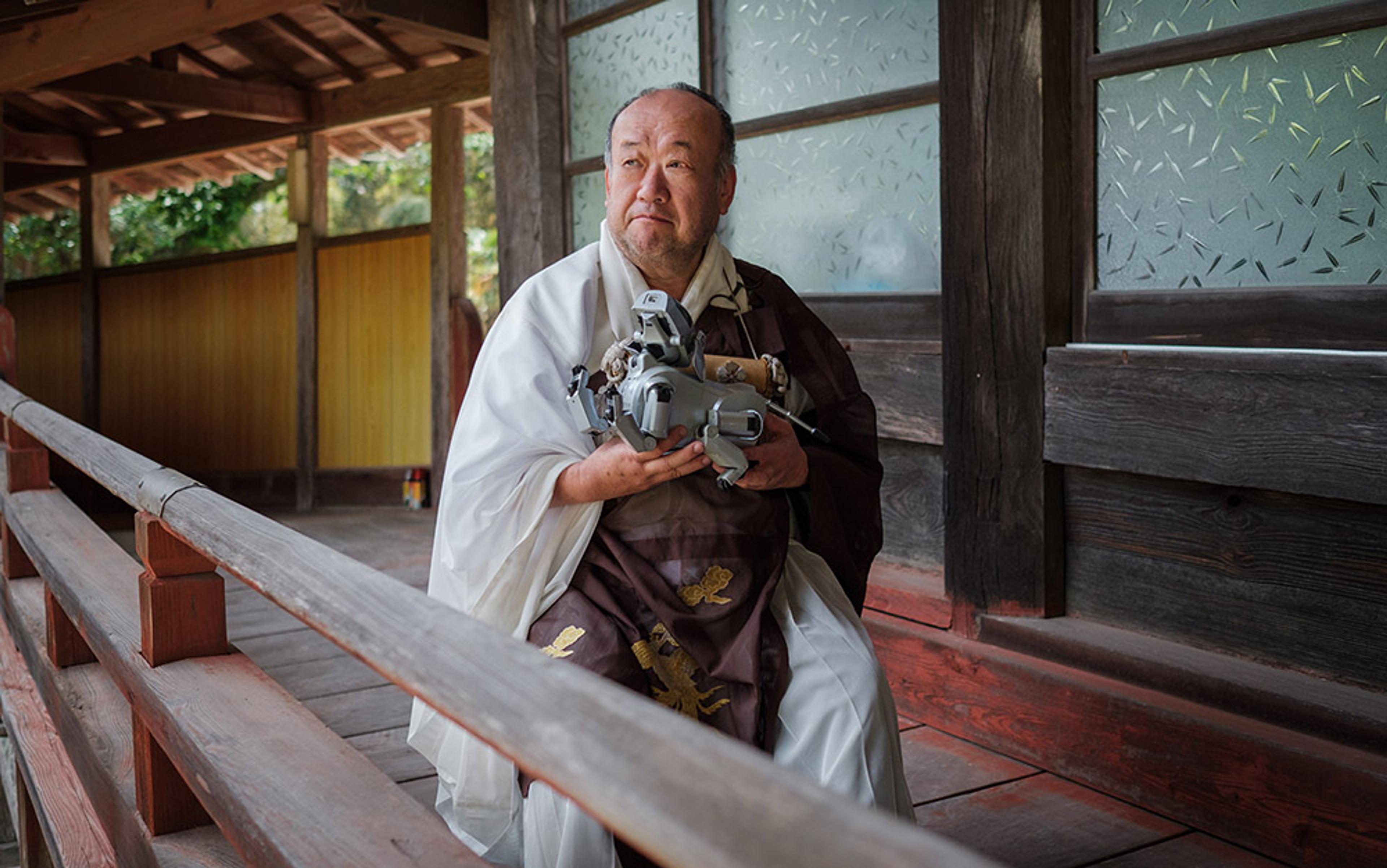What does the word ‘robot’ bring to mind for you? There’s a good chance it’s some character from science fiction. C3PO from Star Wars, maybe, or, if you’re more pessimistically minded, the killing machine from the Terminator movies.
The concept of high-tech machines shaped like humans has been with us for the better part of a century. The word ‘robot’ itself, derived from the old Slavonic word rabota, meaning ‘servitude’, dates back to 1921, when it appeared in the Czech play R U R (Rossum’s Universal Robots) by Karel Čapek. Then, the robots in the play were, of course, played by human actors, and thus humanoid in appearance. Yet this early work set the stage for what form robots should take in our imagination; from the novels and short stories of Isaac Asimov to the androids of the movies, they have, for the most part, looked, acted, and even experienced the world like us.
The reality of today’s work-a-day robots is quite different. Robots in the real world usually look nothing like us. On Earth they perform such mundane chores as putting car parts together in factories, picking up our online orders in warehouses, vacuuming our homes and mowing our lawns. Farther afield, flying robots land on other planets and conduct aerial warfare by remote control.
More recently, we’ve seen driverless cars take to our roads. Here, finally, the machines veer toward traditional R U R territory. Which makes most people, it seems, uncomfortable. A Harris Interactive poll sponsored by Seapine Software, for example, announced this February that 88 per cent of Americans do not like the idea of their cars driving themselves, citing fear of losing control over their vehicles as the chief concern.
The main difference between robots that have gone before and the newer variety is autonomy. Whether by direct manipulation (as when we wield power tools, or grip the wheel of a car) or via remote control (as with a multitude of cars and airplanes), machines have in the past remained firmly under human control at all times. That’s no longer true and now autonomous robots have even begun to look like us.
I got a good, long look at the future of robotics at an event run by the Defense Advanced Research Projects Agency (known as the DARPA Robotics Challenge, or DRC Trials), outside Miami in December. What I saw by turns delighted, amused, and spooked me. My overriding sense was that, very soon, DARPA’s work will shift the technological ground beneath our feet yet again.
DARPA is the US government agency that gave us such breakthroughs as the internet, satellite navigation systems, stealth airplanes, and the aforementioned driverless cars. This small agency operates on a shoestring budget that’s about 0.5 per cent of the US Department of Defense’s total. Run by 100 or so programme managers and their support staff, it has had a disproportionately large impact on our technological society. And the agency is at it again, pushing the frontiers of robotics, specifically in the area of general-purpose, semi-autonomous humanoid robots.
The December sky was bright and blue, the air clear and warm at the Homestead-Miami Speedway, where the DRC Trials took place. Sixteen teams from three countries (one each from Japan, Korea and Hong Kong, and the rest from the US) and their robots had come together to compete for up to $1 million each in DARPA funding to continue their work. Teams fielded by such mainstays of innovation as MIT, Carnegie Mellon and NASA competed against upstarts from small companies, and even one group of volunteers who built their bot on nights and weekends. All put their machines to the test in eight separate tasks.
The proceedings reflected more of the hurry-up-and-wait pace of a golf match than the auto races normally held at the speedway. By the second day of the two-day competition, I was used to the slow, plodding motions of the robots. Many of them looked supremely capable, even deadly, especially the Atlas made by Boston Dynamics. The Atlas served as the hardware platform on which nearly half of the teams competing sought to push the programming envelop in the fields of machine learning, vision, perception, and planning (the other teams brought robots of their own design).
Atlas certainly resembled the deadly Terminator more than the affable C3PO. Stripped of flesh and standing implacable in all its nude hydraulic glory, it was a study in black plastic and chrome. Just above its video-camera eyes, through which it transmitted a view of the world around it, a ‘lidar unit’ (the word is a combination of ‘light’ and ‘radar’) spun to scatter invisible laser light the way radar transmits radio waves. The light, reflected back at the machine from the objects around it, allowed its tiny brain to build up a picture of the world for itself.
With its stooped posture and stunned inaction, the robot looked like nothing so much as a dunce made to stand in a corner for not learning its lessons properly
But for all its apparent capacity for work and even mayhem, it was a baby, barely aware of the world and how to move about within it. I watched as an Atlas belonging to one of the teams stared in apparent perplexity at a door handle. With its slightly stooped posture and seemingly stunned inaction, the robot looked like nothing so much as a dunce made to stand in a corner for not learning its lessons properly.
And so it went. The 16 robots moved with varying degrees of struggle through their tasks, which had been developed by the DARPA programme manager behind the DRC, Gill Pratt (an MIT-trained electrical engineer and computer scientist), and his staff.
Pratt’s impetus for creating the DRC was the unprecedented meltdown of three nuclear reactors at the Fukushima Daiichi power plant in Japan that followed the earthquake and tsunami of March 2011. When the earthquake struck Japan’s Pacific coast, the plant’s nuclear reactors stopped operating (as designed) but the subsequent tsunami inundated the plant’s backup generators and three of its oldest reactors failed to shut down. As the reactor cores melted, hydrogen gas built up in the containment buildings. The gas exploded, blowing the roofs off the buildings and showering the area around the plant with radioactive debris. Three years after the accident, an area 12 miles around the plant is still deemed unsafe for human habitation by the Japanese government, and radioactive groundwater continues to drain into the Pacific.
A good deal of this mess could have been avoided, according to a report in the November 2011 issue of the technology magazine IEEE Spectrum, which inspired Pratt to create the DARPA Robotics Challenge. ‘If workers had been able to vent gases in reactor 1 sooner,’ wrote Eliza Strickland in the report, ‘the rest of the plant’s destruction might well have been averted.’
As it was, once the meltdown had started, the buildings quickly became lethal hot zones, preventing workers from going in to open the valves that would have vented the gas. DARPA’s director, Arati Prabhakar, told me at the DRC Trials: ‘Everyone in the robotics community looked at that and said, if we had the kinds of capabilities we’ve been dreaming of, think what a difference it would have made to have robots be able to intervene in this complex, human-designed environment that is now poisoned.’
The challenge of enabling a machine to accurately perceive the ever-changing world around it, formulate plans for moving about, and then execute those plans before the information taken in through its sensors becomes hopelessly out of date, (functions that most two-year-old children are pretty good at) is what DARPA programme managers term ‘DARPA-hard’.
It’s hard because each one of those functions – perception, planning, movement – requires powerful yet portable computers to make lots of calculations in the shortest amount of time possible. That is why robots have until recently been relegated to controlled environments such as factories, where the number of variables requiring calculation can be kept to a minimum.
But DARPA has proven, through the Grand Challenge and Urban Challenge auto races of 2004, 2005, and 2007 that led to the development of driverless cars, that robots can be made to function autonomously in the chaos of the real world. Computers have gotten fast enough and small enough, and sensors and algorithms have gotten powerful enough, to make autonomous navigation through city streets at least possible.
‘Part of the difficulty with science fiction is that people can get the idea that these things aren’t actually very hard to build’
Even so, robots with wheels don’t have to devote processor cycles to balancing themselves. They don’t have to switch gears from simply moving forward to the wholly different locomotive mode of climbing. They don’t have to make sense of unpredictably degraded environments such as ruined buildings; and they don’t have to use tools. All of which tasks were required of the robots at the DRC Trials.
Pratt and his colleagues designed the eight challenges for the DRC robots to approximate tasks that human emergency workers would perform – if they could – in environments that were too dangerous for them. These included driving a vehicle a short distance; removing debris from a path ahead; opening doors; connecting a fire hose to a standpipe; climbing a ladder (actually more of a steep staircase); using a power tool to cut a hole in a wall; turning wheels to simulate opening valves; and traversing uneven ground on foot.
As if those simple-for-humans-but-hard-for-robots tasks weren’t challenging enough, the machines competing in the DRC had to contend with another layer of difficulty. The data passed between robot and human operators ensconced out of visual range had to be transmitted over a degraded communications link, which Pratt described as oscillating between the quality of a good mobile connection and a lousy one. Hence the need for autonomy. Or, in this early stage of the game, semi-autonomy. Instead of reacting to direct input from their operators, the machines had to interpret high-level commands such as ‘move toward that door’, or ‘put your right arm out to the door handle’. In other words, the machines had to start to think for themselves.
Pratt conceived this initial DRC event as the first in a series. The DRC Trials in Miami were to serve as a kind of calibration point, to get a fix on the state of the art in robotics on which to build for next year’s DRC Finals. ‘I think part of the good that can come out of the Trials is that we actually help calibrate the public to what reality is in this field,’ he said in a conference call with reporters before the event. ‘Part of the difficulty with science fiction is that, if there’s no counter-example – science fact – people… can get the idea that these things aren’t actually very hard to build. So besides calibrating ourselves to what the state of the art is, I think a lot of the good that we can do here is to calibrate the public.’
Moving that calibration point seems as much an art as a science. Marc Raibert, head of Boston Dynamics, has been at this business for more than 30 years, during professorships at Carnegie Mellon and MIT in the 1980s and ’90s, and since co-founding Boston Dynamics in 1992. Raibert was easy to spot at the DRC Trials in his Hawaiian shirt and without the brightly coloured safety vest required of everyone on the field, as if he felt the rules didn’t apply to him.
Twice on each day of the DRC Trials, Boston Dynamics ran demonstrations of its Legged Squad Support System, or LS3, and Wildcat robots. Though not an actual competitor, Boston Dynamics was instrumental in the success of the DRC, having created the machine used by seven of the 16 teams in the competition. The company has long worked as a DARPA contractor in building animal-inspired robots, including the LS3, which the Marines are now testing for use in carrying soldiers’ gear. DARPA’s plans for Boston Dynamics include upgrading the Atlas to operate from a portable power supply rather than relying on the cables used in the DRC Trials.
As early as the 1960s, programme managers at DARPA contemplated building what they called a ‘mechanical elephant’ or ‘mechanical horse’. The idea was to create a mechanised version of the elephants used by Viet Cong soldiers in the Vietnam War. The animals enabled food and ammunition to go where Jeeps and helicopters couldn’t. According to a book-length history of DARPA commissioned by the agency in the 1970s, the then-director quietly buried the ‘mechanical elephant’ idea, fearing ridicule if word of it got out.
Fifty years on, however, technology has caught up with imagination. Boston Dynamics have, in fact, created what amounts to a mechanical horse, in the form of the LS3. ‘Animals do all the things we’d like to make machines do,’ Raibert told me at the DRC Trials. ‘They can climb mountains. They can go in very difficult terrain. People and animals using their legs can go almost anywhere on Earth. And yet, wheeled and tracked things are very limited in the number of places they can go. So the dream is to be able to get animal-like mobility out of these machines by giving them the same techniques as the animals use.’
In the demonstrations, a Boston Dynamics engineer holding a radio controller commanded an LS3 to get up from its standby kneeling position, which it did with alarming dexterity, accompanied by a deep-throated whine of the gasoline engine powering it. The machine then trotted off for a jog on a track at the speedway.
As dexterous as it is, the LS3 is still a long way from the supervised autonomy that Pratt wants the DRC robots to demonstrate. Although the machine can keep itself upright and even follow a human walking in front of it, it still needs an operator nearby to guide it along. It also has even further to go before it can match the smarts and dexterity of an actual animal, Raibert told me. ‘Animals have lots and lots of muscles, lots and lots of parts of the brain that control those muscles, very strong skeletons, and things like that. [That] complexity is almost free for animals, but for engineering, complexity’s very expensive. So that’s the palate we have to work with.’
And yet the LS3’s very existence demonstrates how new technologies often seem hopelessly out of reach…until they don’t. DARPA programme managers have succeeded in crossing this chasm too many times to count since the agency was founded in 1958. And so it was with quiet confidence that DARPA’s deputy director, Steven Walker, told me, while we stood watching a robot navigate the uneven terrain challenge, that he was sure the DRC bots would be moving with the speed and agility of the LS3 at the very next event. Walker has himself presided over one of DARPA’s more spectacular successes. As programme manager in charge of hypersonic vehicles, he guided development of the world’s fastest air-breathing aircraft, the X-51A scramjet.
Not a single driverless vehicle was able to finish the first Grand Challenge in 2004, which was pretty much a straight sprint across open desert. But the next race, just a year later, had five finishers. And by the time of the third and final race, in 2007, the competing cars were successfully navigating simulated city streets along with human-driven traffic. These days, automakers are building more ‘active’, ie autonomous, safety features into production cars every year, with the barriers to full autonomy being more social and political than technological. Pratt, Walker, Prabhakar and all the teams competing in the DRC can see the way forward for autonomous humanoid robots as clearly as the Lidar (light, detection and ranging)-produced point clouds their machines use to build up a picture of their surroundings.
No sooner than I’d come to accept a relatively low level of competence among the robots of the DRC, I caught sight of Team SCHAFT’s squat, bright-blue bipedal machine – essentially a box of computers studded with sensors and sprouting arms and legs – striding across the uneven terrain challenge. Where the other bots were slow and hesitant, this machine seemed purposeful, even confident. It easily navigated the collection of cinder blocks placed haphazardly across its path. In the ladder challenge, it charged up two steps at a time, reaching the top well within the time limit.
SCHAFT’s team leader Yuto Nakanishi – who spent most of every challenge event intently focused and quiet – punctuated each of his bot’s successes with a shout of victory and raised fists. Clearly, SCHAFT was in this thing to win. And win it did. The team was a private company spin-off from Tokyo University. It was only fitting that the winner of the DRC comes from Japan – the site of the crisis that sparked the competition.
Meanwhile, in a replay of Google’s work in self-driving cars – which began when it acquired a winning Grand Challenge team in 2005 – the search-engine giant confirmed a week before the DRC Trials that it had bought SCHAFT in partnership with Boston Dynamics. With the former DARPA director Regina Dugan already on board – as the head of advanced technology and projects at the Google subsidiary Motorola – Google was starting to look like a civilian DARPA.
it’s only a matter of time before humanoid robots become just another part of our technological landscape, along with driverless cars and wearable internet access
SCHAFT and Boston Dynamics join five other recent robotics purchases by Google. No doubt about it, Google, one of the most successfully innovative companies on the planet, is betting big on robotics. The company is notoriously tight-lipped about its future plans, but it’s not hard to see where this is going. Like it our not, it seems only a matter of time before general-purpose, semi-autonomous humanoid robots become just another part of our technological landscape, right along with two other Google-funded innovations: driverless cars and wearable internet access.
Disaster zones represent just one area in which general-purpose robots designed to work in human-created environments will likely make themselves useful. The home is another. Although ‘smart’ devices in the home – robotic vacuum cleaners, connected thermostats, lights, sprinklers, and so on – are often seen as expensive novelties reserved for those who can afford them, they might well come to be viewed as necessities for a growing population.
The number of people over the age of 65 in industrial nations is rising faster than the number of people available to help them with tasks with which they will increasingly need a hand. The number of Americans over 65, for example, will hit 72.1 million by 2030, more than double the number in 2000, according to the US Department of Health and Human Services. In Japan, whose ageing population is growing faster than any other in history, a quarter of the total population will be 65 or older by 2050, according to the Japanese National Institute of Population and Social Security Research.
The DRC programme manager Gill Pratt looks at those trends and sees robots – robots helping people in their homes just as dishwashers and vacuum cleaners do now. Nor does Pratt want to limit DRC-style bots, whose prototypes are relatively expensive, to big, high-profile disasters such as Fukushima. He foresees a day when large production runs will make them affordable enough for fire departments around the world. In that scenario, they would be just another tool available to first responders along with fire trucks and defibrillators.
‘If they have humanoid robots that work pretty well, they’re going to want robot soldiers in urban battlefields’
Pratt insists that the bots of the DRC are intended for purely humanitarian purposes and that DARPA has no plans to weaponise them. But Mark Gubrud of the International Committee for Robot Arms Control, for one, isn’t buying it. He sought me out as I joined the minor throng watching Team SCHAFT pose for victory photos. ‘I think the importance of this event, first of all, is the fact that it is sponsored by DARPA,’ he told me, ‘so clearly there’s interest in robot soldiers. That’s clearly the long-term goal here, as well as robots to do other dull, dirty, and dangerous jobs. Clearly, in the long-term, if they have humanoid robots that work pretty well, they’re going to want robot soldiers in urban battlefields.’ Boy, what a killjoy. He’s probably right, though. Very likely, C3PO and Terminator are equally destined to be part of our future.
The robots of the DRC will be back on the field as early as this December, most likely much, much more capable than before, after their teams have a further year to work on improving the hardware and software that drives them. The eight best teams from the DRC Trials are in line for DARPA funding to help them along, but many of the others, including the all-volunteer team Mojavaton, will continue on their own dime, undaunted. Immediately at stake is a $2 million prize from DARPA. But more than that, the competition promises to launch yet another DARPA project from the realm of science fiction into the mainstream by once again proving the seemingly impossible to be, in fact, possible. The repercussions will be profound – our squeamishness about autonomous machines notwithstanding.
If DARPA’s deputy director Steven Walker is right, we can expect the robots competing in the future DRC Finals to demonstrate the ability to smoothly and efficiently perform such tasks as walking from place to place, using power tools, and perhaps even driving cars with their own processors doing most of the work of interpreting human commands. From there – if the road taken by driverless cars is any indication – humanoid robots will be just a few years of development (by companies such as Google) away from much greater autonomy. Such machines will be able to independently perceive and navigate the world around them while interpreting and responding as they see fit to high-level commands from human operators. And, all the while, the day that humanoid robots invade our lives as helpers, first responders and enforcers draws inexorably closer.






